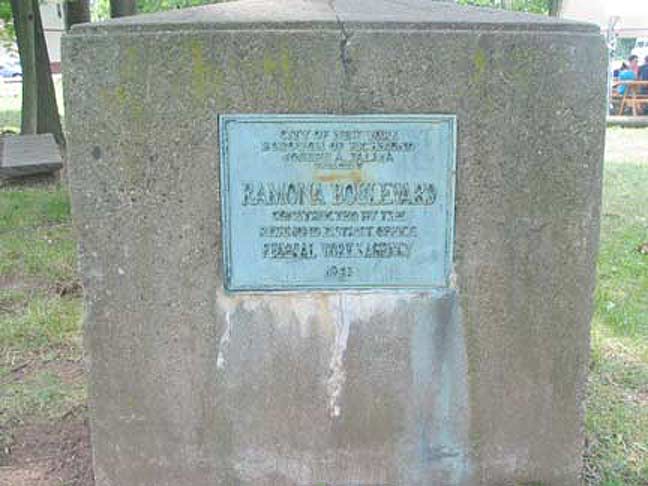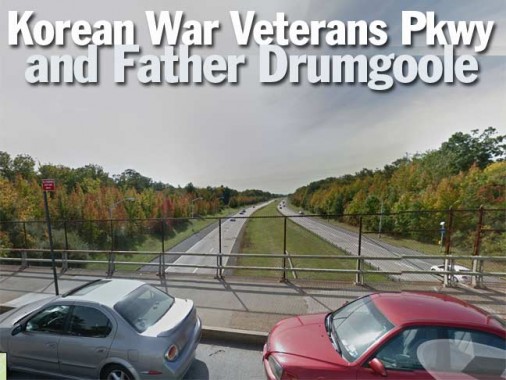A busy, though unfinished, parkway runs through southwest Staten Island, connecting the junction of Richmond Avenue and Arthurkill Road with the Outerbridge Crossing, built in the 1920s as a connection to Perth Amboy, New Jersey. The road has been in existence since 1941 and, for part of its history was one of two major roads named for Catholic priests (though not at the same time*). The name Drumgoole has been associated with the road almost since its beginnings.
John C. Drumgoole (1816-1888) immigrated from County Longford, Ireland, in 1825 to join his mother in America after his father’s death, and took work as a shoemaker when he became of age. He became the sexton and janitor of St. Mary’s parish in Manhattan’s Lower east Side in 1844, the third oldest NYC parish, and took a special interest in the thousands of homeless and orphaned children wandering the streets after coming to America in the aftermath of Ireland’s potato famine of the 1840s, or were left parentless during the Civil War. He provided food and shelter to these destitute youth in the basement of St. Ann’s for 21 years.
Drumgoole had always aspired to the Catholic priesthood and after attending St. John’s College in the Bronx, now Fordham University and the Seminary of Our Lady of Angels near Niagara Falls, he was ordained at age 53 in 1870. He continued to help homeless children in the succeeding years.
In those days tuberculosis and influenza ran rampant in the city’s poorer sections and it was thought that fresh air played a large part in recuperation and recovery. Thus, Fr. Drumgoole sought property well outside of town and in 1882 purchased the land in southwest Staten Island that is now known as the Mount Loretto orphanage.
Fr. Drumgoole was a great innovator in the field of childcare. The layout of the Mission was designed to provide plenty of light and air to each resident so as to avoid the spread of influenza and tuberculosis, which was common in the tenements of the day. Fr. Drumgoole felt that the general environment of the City at the time was a great threat to younger children, so he sought out a more rural setting. He looked to the Borough of Staten Island and found a farm for sale that must have reminded him of his earliest years in County Longford, Ireland. With the purchase of this and several adjacent lots, Fr. Drumgoole founded Mount Loretto, named as a tribute to the Sisters who accompanied him there to teach the children on a completely self-sufficient farm. Mt. Loretto
In March 1888, Fr. Drumgoole died during an illness acquired when he was caught out during the Blizzard of ’88 that month.

During the 1930s, plans were drawn up to construct a major parkway in southwest Staten Island. At that time, Arthurkill and Amboy Roads were rutted farm-to-market roads, still unpaved in spots.
A concrete slab containing a plaque dated 1941 in Richmondtown Restoration proclaims the existence of Ramona Boulevard, “constructed by the Richmond District Office, Federal Works Agency.” This is the genesis of the parkway, which, as Steve Anderson reports in NYC Roads, was planned as early as 1930 and its first incarnation, as a surface road named Drumgoole Boulevard, was built in the 1940s, with the present sunken parkway arrangement completed in 1972.

In this photo from the Staten Island AD’vance archives, dated January 1941, we’re looking at the opening of Ramona Boulevard, with the roads still awash in slush and the Woodie posts yet to have their gumball luminaires attached. We are looking east from Huguenot Avenue; here the road takes a NE bend toward Richmond Avenue.
This trio of plates from a 1949 Hagstrom atlas shows the extent of Drumgoole Boulevard, for which Ramona Boulevard was quickly renamed, running from Arthurkill Road and Richmond Avenue southwest and west to Arthurkill Road near the Outerbridge.
During an early-1960s bus jaunt to southwest Staten Island I recognize seeing Drumgoole Boulevard, which was still a 4-lane local access road, though major by Staten Island standards at the time.
In the 1960s, traffic czar Robert Moses had big plans for the little parkway named for the founder of Mount Loretto. He would turn it into a major vehicular parkway, sink it in an open cut to avoid traffic signals and connect it to the Outerbridge on the west and then bruit it northeast through several Staten Island communities to flow into the Staten Island Expressway near Clove Lakes Park.
Moses got most of his plans completed, with the new Richmond Parkway opening in 1972 on Drumgoole Road’s old route from Richmond Avenue west to the Outerbridge. In the 1990s, Richmond Parkway was renamed Korean War Veterans Parkway.
As for Father Drumgoole, his name is preserved on the service roads from Richmond Avenue west to Bloomingdale Road.
Moses was stymied, however, in getting Richmond Parkway to connect with the SIE. The road would have been thrust straight through the Staten Island Greenbelt, and the neighborhoods’ opposition to this, plus the city’s precarious finances in the 1960s and 1970s, precluded such an expansion. The approach ramps to Richmond Parkway were, however, built, and enough land was excavated to build a recreational hill known as Moses Mountain in LaTourette Park.
Though urban explorer Nathan Kensinger chronicled the remains of these traffic ramps in 2011, since then the ramps, as well, have been torn down.
1/19/15
*The other major road in Staten Island named for a Catholic priest is Father Capodanno Boulevard in South Beach, named for a Vietnam War hero.
